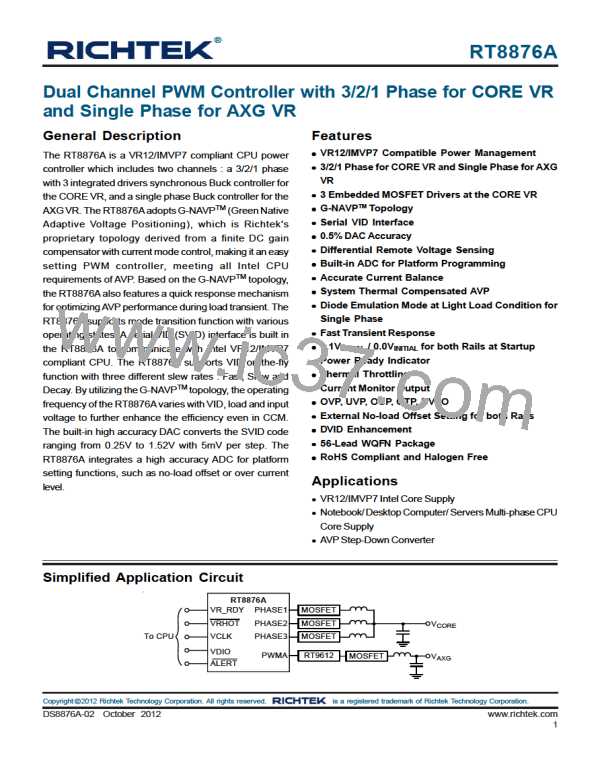RT8876A
Thermal Monitoring and Temperature Reporting
users have to set the TSEN voltage to be 1.515V when
VR temperature reaches 82°C and 1.845V when VR
temperature reaches 100°C. Detailed voltage setting
versus temperature variation is shown in Table 4. The
thermometer code is implemented in Temperature_Zone
register.
The CORE VR provides thermal monitoring function via
sensing TSEN pin voltage. Through the voltage divider
resistors, R1 and RNTC, the voltage of TSEN will be
proportional to VR temperature. When VR temperature
rises, TSEN voltage also rises. The ADC circuit of the
CORE VR monitors the voltage variation at the TSEN pin
from 1.46V to 1.845V with 55mV resolution. This voltage
is then decoded into digital format and stored into
Temperature_Zone register.
VCC5
R1
R
NTC
R2
R3
To meet Intel's VR12/IMVP7 specification, platform users
have to set the TSEN voltage to meet the temperature
variation of VR from 75% to 100% VR max temperature.
For example, if the VR max temperature is 100°C, platform
TSEN
Figure 14. CORE VR : Thermal Monitoring Circuit
Table 4. Temperature_Zone Register
SVID Thermal
Alert
Comparator Trip Points Temperatures Scaled to maximum = 100%
Voltage Represents Assert bit Minimum Level
VRHOT
b7
b6
b5
b4
b3
b2
b1
b0
100%
1.845V
97%
1.79V
94%
1.735V
91%
1.68V
88%
1.625V
85%
1.57V
82%
1.515V
75%
1.46V
voltage. In G-NAVPTM technology, the output voltage is
dependent on output current, and the current monitoring
function is achieved by this characteristic of output voltage.
Figure 15 shows the current monitoring setting principle.
The equivalent output current will be sensed from IMONFB
pin and mirrored to IMON pin. The resistor connected to
IMON pin determines voltage gain of the IMON output.
The current monitor indicator equation is shown as :
The VRHOT pin is an open-drain structure that sends out
active low VRHOT signal. When b6 of Temperature_Zone
register asserts to 1 (when TSEN voltage rises above
1.79V), theALERT signal will be asserted to low, which is
so-called SVIDthermal alert. In the mean time, the CORE
VR will assert bit 1 data to 1 in Status_1 register. The
ALERT assertion will be de-asserted when b5 of
Temperature_Zone register is de-asserted from 1 to 0
(which means TSENvoltage falls under 1.735V), and bit 1
of Status_1 register will also be cleared to 0. The bit 1
assertion of Status_1 is not latched and cannot be cleared
by GetReg command. When b7 of Temperature_Zone
register asserts to 1 (when TSEN voltage rises above
1.845V), the VRHOT signal will be asserted to low. The
VRHOT assertion will be de-asserted when b6 of
Temperature_Zone register is de-asserted from 1 to 0
(which means TSEN voltage falls under 1.79V). It is
typically recommended to connect a pull-up resistor from
the VRHOT pin to a voltage source.
I
x R
R
x R
LOAD
DROOP IMON
(21)
V
IMON
=
IMONFB
where ILOAD is the output load current, RDROOP is the
equivalent load line resistance, and RIMON and RIMONFB are
the current monitor current setting resistors. In VR12/
IMVP7 specification, the voltage signal of current
monitoring will be restricted by a maximum value. Platform
designers have to select RIMON to meet the maximum
voltage of IMON at full load. To find RIMON and RIMONFB
based on :
V
RIMON
IMON(MAX)
(22)
=
RIMONFB IMAX x RDROOP
Current Monitoring and Current Reporting
where the VIMON(MAX) is the maximum voltage at full load,
and IMAX is the full load current of VR.
The CORE VR provides current monitoring function via
sensing the voltage difference of IMONFB pin and output
Copyright 2012 Richtek Technology Corporation. All rights reserved.
©
is a registered trademark of Richtek Technology Corporation.
DS8876A-02 October 2012
www.richtek.com
37

 RICHTEK [ RICHTEK TECHNOLOGY CORPORATION ]
RICHTEK [ RICHTEK TECHNOLOGY CORPORATION ]